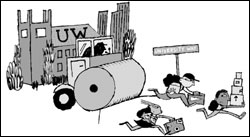LIKE A SOLID MAJORITY of the Puget Sound area’s residents, I wasn’t born and raised here. As such, I suspect my first experiences of Seattle weren’t unusual.
Actually, there were three of them, all centered on the University District. First, my closest high-school friend attended the University of Washington, and I’d come to visit Seattle, staying at his tiny quad (four student rooms connected by a common kitchen). Next, a friend of his offered me a summer job. Finally, I moved here permanently, into a U District apartment with closet-sized “bedrooms” that was designed to squeeze in as many students as possible.
Not that many years later, all three scenarios are essentially nostalgia. The rest of Seattle is no longer an affordable place for most young adults to live. And last week, a City Council rewrite of how the University District is managed took a major step toward turning the UW into a commuter school.
Developers and the UW have long sought abolition of the neighborhood’s “lease-lid” program, which limited the amount of real estate UW could control in areas near its campus, so as to preserve at least some of the fast-dwindling supply of housing that was affordable to young adults.
THE NUMBER OF student-affordable apartments within walking distance of campus is much lower than in the days of the quads (say, 20 years ago); rentable houses are virtually gone. Why? Consider last week’s telling characterization by City Council member Jan Drago, who hailed lease-lid abolition as allowing UW to “remain competitive.”
Well, now. Who, exactly, does the state’s largest land-grant university compete against? (No football jokes, please.)
Drago inadvertently nails the problem: For years, educating students, especially undergraduates, has been an afterthought at UW. Its cancerous lower-campus expansion has been driven almost entirely by corporate and military research contracts; meanwhile, with the Legislature continuously raising tuition and housing costs a cruel joke, the notion of UW as a student’s first experience living away from home is becoming increasingly quaint.
Which brings us to the University District. Here, if anywhere in the city, students’ needs should count for something. Yet, as with the loss of very-low- income housing on downtown’s edges in the past two decades, commerce has once again trumped social need. It seems to be a mantra of Mayor Greg Nickels.
Once off its land-grant campus, UW mostly leases, rather than owns, the property on which its offices sit. What landlord wouldn’t rather have UW as a long-term tenant, instead of a dilapidated house or even six stories of tiny, high-turnover apartments?
MEANWHILE, FOR MORE than a year, the city has been spending money in an ill-conceived effort to remodel the University District’s commercial stripUniversity Way Northeast, aka “the Ave”by tearing up the street a few blocks at a time. Landlords anticipating the lease lid’s death were already leaving storefronts vacant and squeezing the remaining small businesses. Ave construction has further crippled many of them, all so that sidewalks can be widened in places, new lighting fixtures can (eventually) be installed, and street parking can be reduced.
Yet the single aspect that would make the Ave more commercially viable is to have its student-oriented businesses lie directly between students’ homes and where they study. If nobody lives in the University District, far fewer people will have reason to shop there, especially at night. And the new offices replacing the housing will make already awful traffic that much worse.
Encouraging housing in commercial areas has become a central vision for downtown planning, but in the case of the lease lid, Nickels and a majority of the City Council were more interested in deferring to developers and a major institution. In doing so, they steamrolled other considerationsdrowning them out with the short-sighted, automatic mantra of “this will create jobs.”
One such consideration is self-evident: the need of society at large, not just students, to have affordable places for people to live. But since civic Seattle long ago established that it could not care less about affordable housing, consider the particular role of student-friendly housing in bringing bright, ambitious adults to live in the Seattle area.
ANY NUMBER OF LARGE employers Microsoft, for examplewouldn’t be in this region without its base of people drawn here by attending UW. Thatand not just its jobs, or its football teamis why UW itself is considered a civic asset.
Increasingly, unless Mom and Dad already live within commuting distance, young adult students at UW will need the same sort of access to cash required by any exclusive private college. Fewer and fewer will move to this area, and the city will have done its part in killing the dream of accessible higher education.
And it didn’t have to be that way.







